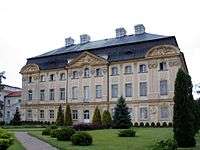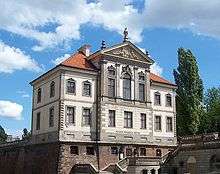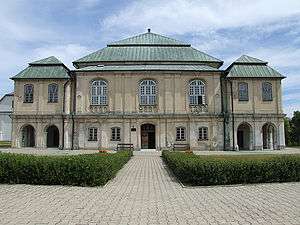Baroque in Poland
| Part of a series on the |
| Culture of Poland |
|---|
| People |
| Traditions |
|
Mythology and folklore |
| Cuisine |
| Festivals |
| Religion |
|
Music and performing arts |
| Sport |
|
The Polish Baroque lasted from the early 17th to the mid-18th century. As with Baroque style elsewhere in Europe, Poland's Baroque emphasized the richness and triumphant power of contemporary art forms. In contrast to the previous, Renaissance style which sought to depict the beauty and harmony of nature, Baroque artists strove to create their own vision of the world. The result was manifold, regarded by some critics as grand and dramatic, but sometimes also chaotic and disharmonious and tinged with affectation and religious exaltation, thus reflecting the turbulent times of the 17th-century Europe.
Baroque and Sarmatism

The Polish Baroque was influenced by Sarmatism, the culture of the Polish nobility (szlachta).[1] Sarmatism became highly influenced by the Baroque style and produced a unique mix of Eastern and Western styles.[1] "East" refers here to the Oriental culture of the Ottoman Empire, not the culture of the Orthodox Muscovy. Those Oriental influences stemmed from a large border shared by Poland with the Ottoman Empire, and it frequent invasions.[1]
Sarmatist thought had praised the idyllic countryside-existence, and the liberal Golden Freedom of the nobility, which stood against the absolute power of the monarchy.[1] Sarmatism stressed the military prowess going back to the times when szlachta first emerged from the knight class; and its religious values, both associated with the historical mission of the Polish people as a bastion of Christianity. Sarmatian nobles felt superior to even the nobility of the other nations, whom they considered non-free and almost enslaved by their rulers (according to Poland's constitution, the king was but an "equal among equals"). With the progression of time, however, the Sarmatism ideals became corrupted. By the time of the 18th-century Enlightenment in Poland, Sarmatism was often regarded as a backward and ultraconservative relic of the past – an opposite of progress, leading the country to its downfall.[2]
On a more material realm, Oriental influences were visible in nobles' attire, arms, and decorations.[1] New Polish costume was based on the Ottoman Empire's robe, which spread from nobility to city dwellers and even peasants. A Polish nobleman wore long robe-like garment such as żupan, delia, and kontusz, often lined with expensive cloth; fitted with a sash belt (pas kontuszowy) and accessorized with knee-high boots from soft leather.[1] Arabian horses were common in Polish cavalry. During the 17th century shaving one's head in the Tatar fashion became popular.[1] The symbol of the noble class was the curved blade weapon, the szabla, a cross between saber and scimitar.[1] Ottoman daggers, sheaths, carpets, helmets, saddles, klims, rugs, tapestries and embroideries were also common: what was not acquired from trade came as loot from many military conflicts along the Commonwealth southern border.[1] The manor (dwór, dworek) of the Polish nobleman was decorated with such war trophies.[1] Some luxury items were of domestic produce, often imitating the Orient style;[1] most were imported from the West via Danzig (Gdańsk) or from the East. Displaying one's wealth was important, and excuses where many: from the name day of the patron saint to weddings and funerals, they be observed in extravagant fashion.[1] A distinctive art of coffin portraits emerged during that period.[1]
Counter-reformation

The Roman Catholic Church became one of the major patrons of the arts; another was the royal house, whose patronage was most visible in the new capital of Warsaw.[1] There the pious Catholic king Sigismund III Vasa sponsored many Baroque sacral constructions. In its first phase, ecclesiastical Baroque architecture was primarily associated with the Jesuit Order, who arrived in Poland in 1564, as part of the counter-reformation, a trend which over the next century would triumph in Poland.[1] The Jesuits established churches and schools in many major cities, slowly winning over the Protestant educational centers in Thorn (Toruń), Danzig and Elbing (Elbląg), and Leszno (where the Comenius school of the Bohemian Brothers was located).[1] The eventual victory of the counter-reformation in Poland would eventually be one of the reasons that would contribute to its cultural stagnation.[3]
Architecture
Early Polish baroque buildings were often designed by foreign (most often, Italian) architects. The first baroque structure in the Polish-Lithuanian Commonwealth was the Corpus Christi Church in Nieśwież (now in Belarus). The first baroque building in present-day Poland was the Church of St. Peter and Paul in Kraków by Giovanni Battista Trevano. The Jewish population in this period was large and prosperous, and many handsome Polish Jewish synagogues were built in baroque style. A handful of these buildings survive, including the Włodawa Synagogue.
Secular Baroque architecture also grew. The royal Warsaw Castle was reconstructed between 1596 and 1619 by the Italian architects Giacomo Rotondo, Matteo Castelli and Jan Trevano.[1] Outside the Castle, a column with the Statue of King Zygmunt, sculpted by Clemente Molli and cast by Daniel Tym was raised by his son, Władysław IV Waza, in 1644.[1] Park Ujazdowski with a new palace, the palace of Ujazdów, was built by Trevano between 1619 and 1625.[1] Palace of Ujazdów was soon overshadowed the Wilanów Palace, raised by King John III Sobieski between 1677 and 1696.[1] Style of those new royal mansions was soon imitated by numerous magnates who did not want to fall behind the times, leading to numerous baroque residences springing throughout Polish countryside, such as at Kruszyna (1630, built for Voivode Kasper Doenhoff), Łańcut (1629–1641, rebuilt for Stanisław Lubomirski),[4] Wiśnicz (1616–1621, also for Stanisław Lubomirski), Ujazd (Krzyżtopór built in 1628-1644 for Krzysztof Ossoliński).[1]
Prominent examples of Baroque style
- Churches
-

Visitationist Church in Warsaw
-

Basilica of the Blessed Virgin Mary, Święta Lipka
-

King's Chapel by Tylman van Gameren, Gdańsk
-

Monastery of Philip Neri's Oratory, Głogówko
-

Visitation of Our Lady Basilica, Wambierzyce
- Palaces
- Castles
- Tenements
- Interiors
-

Palace in Nieborów
- Church interiors
- Judaica
References
- 1 2 3 4 5 6 7 8 9 10 11 12 13 14 15 16 17 18 19 20 21 Michael J. Mikoś, Polish Baroque and Enlightenment Literature: An Anthology. Ed. Michael J. Mikoś. Columbus, Ohio/Bloomington, Indiana: Slavica Publishers. 1996. 104-108. ISBN 0-89357-266-7 Cultural background
- ↑ Andrzej Wasko, Sarmatism or the Enlightenment: The Dilemma of Polish Culture, Sarmatian Review XVII.2.
- ↑ (English) Robert Bideleux, Ian Jeffries (1998). A history of eastern Europe: crisis and change. Routledge. p. 153. ISBN 0-415-16112-6.
- ↑ (English) "Castle's history". www.zamek-lancut.pl. Retrieved 2010-08-01.

























